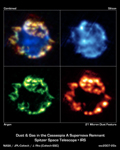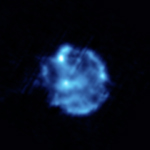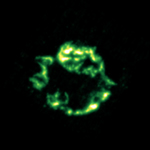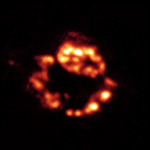
4-Panel Version
Figure 1 |  |  |
Silicon Gas
Figure 2 | Argon
Figure 3 | Dust Collection
Figure 4 |
This beautiful bulb might look like a Christmas ornament but it is the blown-out remains of a stellar explosion, or supernova. Called Cassiopeia A, this supernova remnant is located about 10,000 light-years away in our own Milky Way galaxy. The remains are shown here in an infrared composite from NASA's Spitzer Space Telescope. Silicon gas is blue and argon gas is green, while red represents about 10,000 Earth masses worth of dust. Yellow shows areas where red and green overlap.
The fact that these two features line up (as seen in yellow in the combined view) tells astronomers that the dust, together with the gas, was created in the explosion. This is the best evidence yet that supernovae are a significant source of dust in the early universe—something that was postulated before, but not proven. Dust in our young universe is important because it eventually made its way into future stars, planets and even people.
In figure 1, the upper left panel is a composite made up of three infrared views shown in the remaining panels. The bottom left view (figure 3) shows argon gas (green) that was synthesized as it was ejected from the star. The upper right panel (figure 2) shows silicon gas (blue) deep in the interior of the remnant. This cooler gas, called the unshocked ejecta, was also synthesized in the supernova blast. The bottom right view (figure 4) shows a collection of dust (red), including proto-silicates, silicate dioxide and iron oxide.
The data for these images were taken by Spitzer's infrared spectrograph, which splits light apart to reveal the fingerprints of molecules and elements. In total, Spitzer collected separate "spectra" at more than 1,700 positions across Cassiopeia A. Astronomers then created maps from this massive grid of data, showing the remnant in a multitude of infrared colors.

